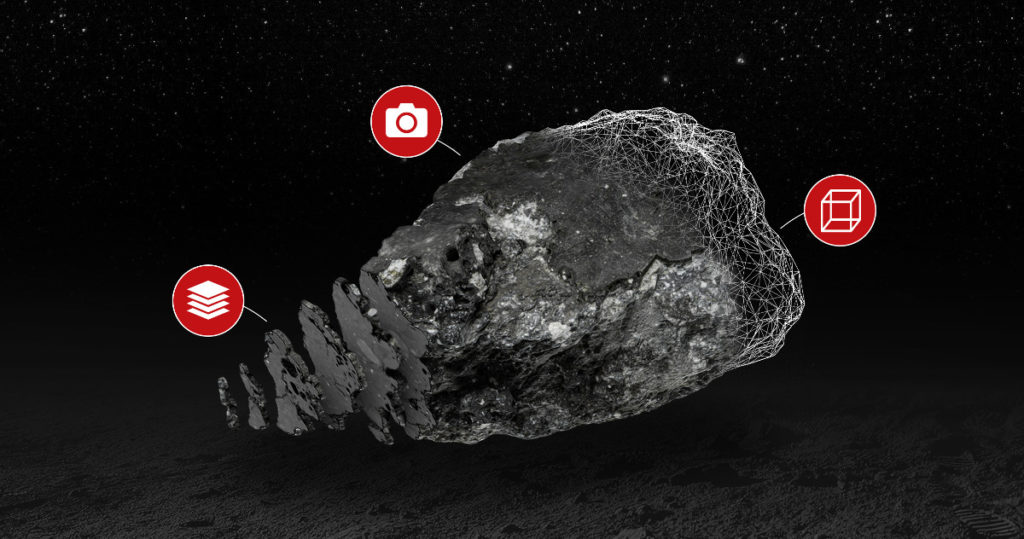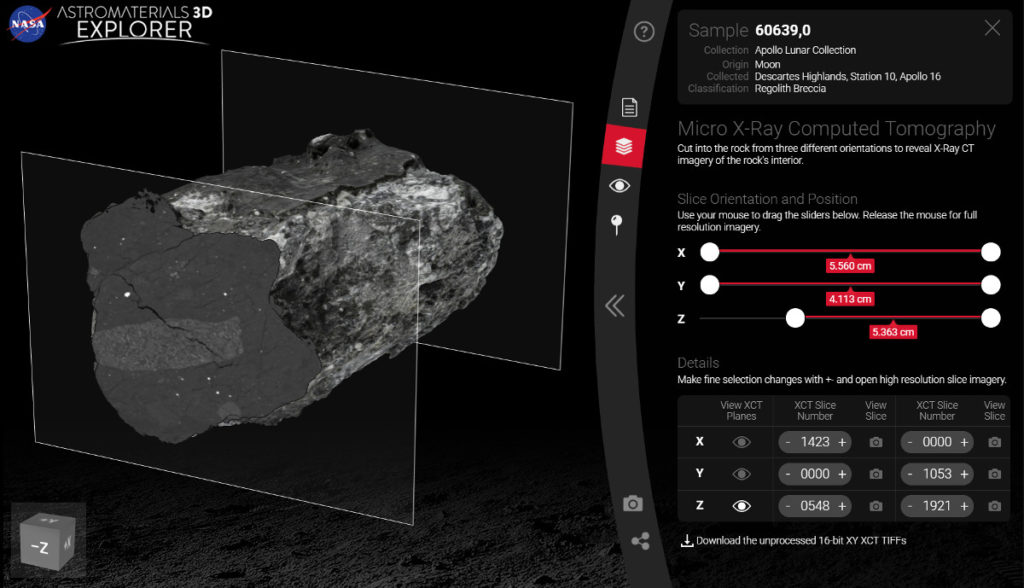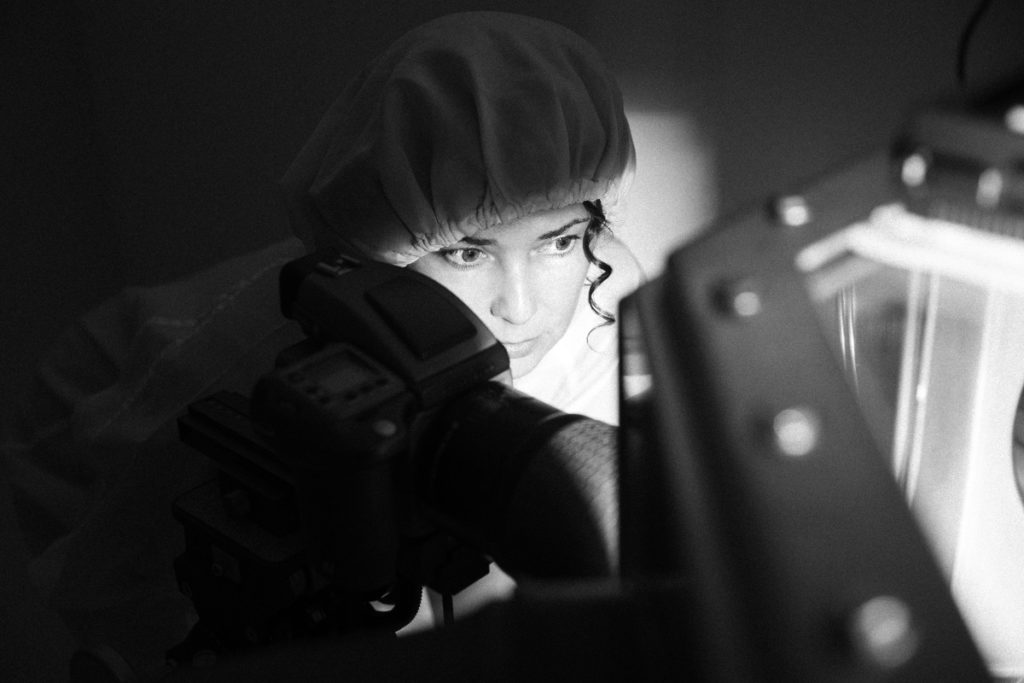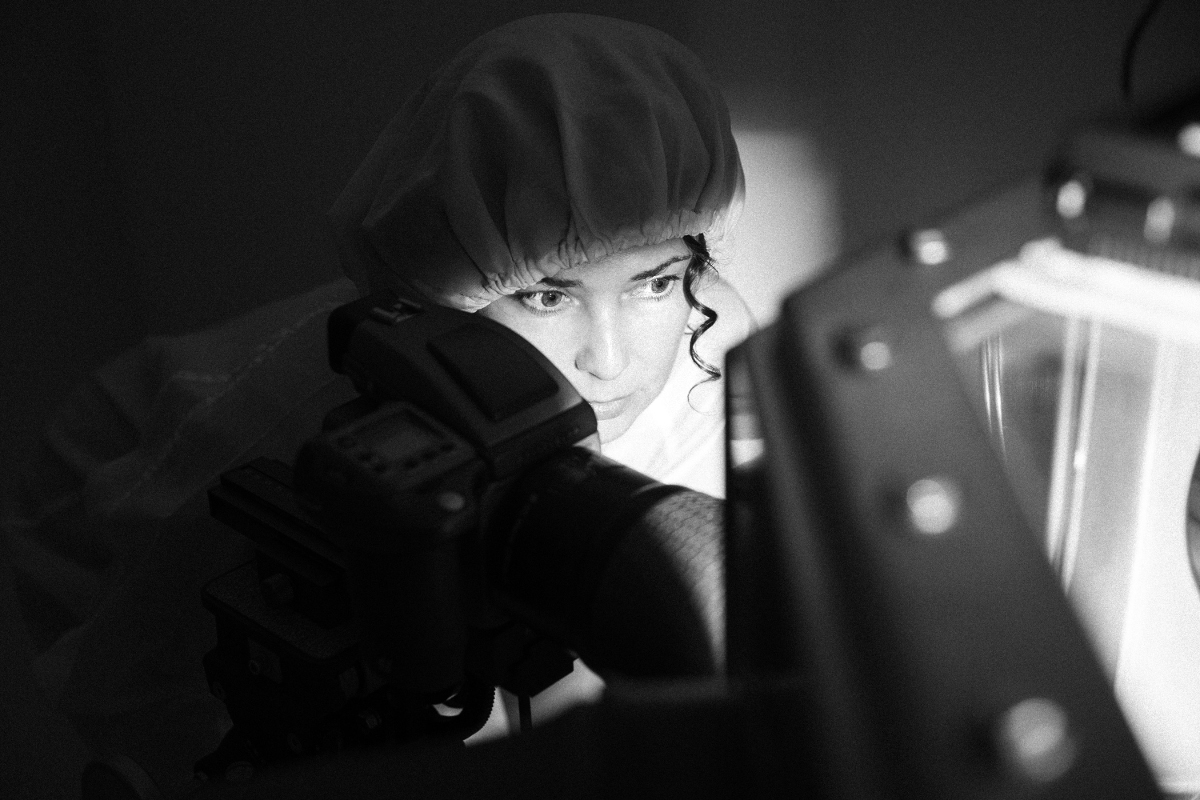La NASA a lancé un nouveau site permettant de manipuler les roches provenant d’autres planètes comme si on l’avait entre les mains. Une aubaine pour les scientifiques du monde entier.
Les collections d’échantillons d’astromatériaux de la NASA, comprennent une bibliothèque d’échantillons de météorites lunaires et antarctiques Apollo. Aujourd’hui elles sont toutes disponible en ligne via un nouvel outil d’exploration virtuelle destiné aux chercheurs scientifiques et au grand public. Le site Astromaterials 3D Explorer offre un outil de recherche sans précédent pour engager le public d’une nouvelle manière d’explorer l’importance des collections de roches spatiales de la NASA.
Le partage virtuel des échantillons d’Apollo, qui ont été collectés il y a environ 50 ans, est particulièrement opportun car la NASA se prépare à envoyer un nouveau groupe d’astronautes sur la Lune avec le programme d’exploration lunaire Artemis. L’objectif de l’agence sera d’explorer d’avantage la lune et de collecter plus d’échantillons à l’aide des robots et des humains.
[bctt tweet=”NASA – Des roches provenant d’autres planètes maintenant pratiquement disponibles – Science” username=”tedidevblog”]
Les échantillons présentés par la NASA

Les échantillons présentés sur le site Web ont été stockés et conservés à l’abri sur Terre dans un état impeccable depuis leurs collisions avec la Terre ou leur ramassage par les astronautes d’Apollo qui parcouraient le sol lunaire.
«La plupart des échantillons sont conservés pour la recherche scientifique. Certains sous-échantillons sont disponibles pour les éducateurs ou dans des expositions et des installations à travers le monde, mais la majeure partie de la collection est dans une salle blanche voûtée pour leur préservation et leur protection », a déclaré Erika Blumenfeld, chercheuse principale et chef de projet pour la science des astromatériaux 3D , au Johnson Space Center de la NASA à Houston.
“Trouver un moyen de rendre ces échantillons plus accessibles fait partie de notre objectif d’élargir les connaissances des gens sur les échantillons et l’exploration.”
Tenir les pierres entre les mains

Grâce au nouveau site, un chercheur, un enfant curieux et tous ceux qui se trouvent entre les deux peuvent, «dans un sens, tenir les pierres entre leurs mains», a déclaré Blumenfeld.
Le site Web propose également un voyage virtuel à travers la Voie lactée avant que les téléspectateurs puissent se plonger dans la découverte d’un échantillon spécifique.
«Notre objectif est de faire en sorte que l’utilisateur se sente à l’intérieur du système solaire interne ou de la ceinture d’astéroïdes», a déclaré Blumenfeld.
«Nous voyons des météorites, nous lisons à leur sujet et nous connaissons les roches de la Lune, mais Astromaterials 3D apporte vraiment ce sens de l’imagination et de l’exploration de manière viscérale et visuelle.
Ensuite, en sélectionnant un échantillon, «les gens peuvent réellement interagir individuellement avec les roches et avoir la possibilité de s’interroger, de poser des questions, d’étudier et de faire des recherches», a déclaré Blumenfeld.
L’histoire est dans la roche
«Je pense que chaque rocher a sa propre histoire d’origine», a déclaré Blumenfeld. «Les roches sont des conteurs, des voyageurs dans le temps… J’ai été inspiré en écoutant les géologues parler de leur intérêt particulier pour certains processus géologiques. Inévitablement, vous les entendrez toujours dire: «Mais l’histoire est dans la roche.» »
Les spectateurs qui naviguent à travers les échantillons sur le site peuvent suivre l’histoire de chaque roche, apprendre ce qui est arrivé à la roche – et la suivre jusqu’à sa destination ultime, comme l’Antarctique dans le cas des météorites.
Pour certains des échantillons prélevés sur la Lune, il est possible de regarder des images réelles du spécimen collecté par l’astronaute. Vous trouverez aussi sur le site Web, le premier échantillon jamais collecté sur la Lune – l’échantillon de contingence d’Apollo 11 ramassé par l’astronaute Neil Armstrong – et trois autres d’Apollo 17. Des images supplémentaires de l’ère Apollo seront disponibles à mesure que de nouvelles missions seront en ligne.
Une aubène pour tous les scientifiques du monde d’entier

Chaque échantillon offre des vues de pointe de la matière à l’intérieur. Ceci est possible sans recours à des techniques destructrices pour examiner sa composition et ses origines.
Sur le site Web se trouve une «version numérisée de la roche, une visualisation 3D de la chose réelle», a noté Blumenfeld. “Il utilise donc la technologie actuelle pour obtenir une résolution suffisamment élevée, ce que nous appelons un modèle 3D de qualité recherche.”
Pour créer ces modèles, l’équipe multidisciplinaire a photographié manuellement les roches sous 240 angles différents minimum. Ce travail a été réalisé sur la roche enfermée dans une armoire à azote de la salle blanche en utilisant des photographies à très haute résolution. Ensuite, chacune a été scannée à l’aide de la tomodensitométrie aux rayons X (CT).
Les scans internes et externes sont intégrés sur le site Explorer, où vous pouvez voir à la fois l’intérieur et l’extérieur de l’échantillon simultanément et le disséquer virtuellement.
Cette modernisation des pratiques de documentation dans le domaine de la conservation crée également de meilleures opportunités pour une science ciblée. «C’est une nouvelle première étape pour les analyses, car les tomodensitogrammes fournissent une analyse en soi – et ces données peuvent maintenant être téléchargées et importées dans d’autres logiciels qu’un chercheur peut ensuite interroger et faire de très bonnes déterminations sur ce que dont la roche est faite », a déclaré Blumenfeld.
Partage de toute la collection de la NASA
Le site comprend actuellement 10 météorites et 10 échantillons lunaires. Au début de l’été 2021, des échantillons supplémentaires de la collection d’échantillons d’astromatériaux de la NASA seront disponibles.
“Les roches ont suscité la curiosité et l’émerveillement en nous depuis le début“, a déclaré Blumenfeld. «Je pense qu’il existe une relation incroyable entre les humains et les roches depuis aussi longtemps que nous sommes sur la planète. Et, le fait que ces roches se réfèrent également à notre planète et comment notre planète s’est formée, et ce qui est au-delà de notre planète, est vraiment ma motivation. Il s’agit de relier ces incroyables connexions à travers tout le cosmos, en comprenant que nous y sommes inextricablement liés. C’est grâce à l’étude des astromatériaux que nous avons finalement pu corréler le fait que nous sommes faits d’étoiles. ”
Et bien que nos propres origines puissent être plus faciles à retracer, les gens du monde entier pourront désormais faire leurs propres recherches pour savoir où et comment tout a commencé.
Crédits
Le site a été créé par une équipe de la Division de la recherche et de l’exploration des astromatériaux de la NASA Johnson.
Site web : ares.jsc.nasa.gov/astromaterials3d
Auteure : Catherine Ragin Williams, Centre spatial Johnson de la NASA
Conclusion
Vous aimerez peut être découvrir Science : Pour la première fois, on a une image haute définition de la Nébuleuse de la carène située à près de 8500 années lumière de la Terre et 10 faits réels que vous ignorez probablement sur le monde marin
Source : nasa.gov

